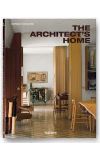
22 Apr 2013 01:50:08
They can choose, as The Architect's Home describes, to make demands of themselves they would find harder to impose on others. Arne Korsmo, in Oslo, wanting a wide column-free living space, made his house five times more expensive than otherwise similar houses he had designed next door. Jan Benthem, in Almere, Holland, created tiny 2m x 2m bedrooms furnished only with narrow bunks. But mostly they don't need be so self-punitive: it's more that they can get the details just as they want them, and then live in the house in ways that its design proposes.
The Architect's Home is 480 pages of evidence to refute the anti-moderns' charge, with 100 projects by European architects, mostly from the past 100 years. It is a production of Taschen, the well-known factory of stylish art-and-porn, and might be thought a coffee-table book, but an earnest introduction by the editor Gennaro Postiglione sets out a higher ambition. The book, he says, "intends to supply the legitimation for the very existence of a theory and poetics of interior design" and "to promote understanding of architecture that pays regard both to the occupants and to the ideas of the designers".
The selection is refreshing. Alongside Le Corbusier, Gropius and Aalto are some much more recherché names – Gaston Eysselinck, anyone? – with a geographic sweep that, while possibly favouring Scandinavia and Switzerland, and neglecting eastern Europe, is wide. There are omissions, most strangely Konstantin Melnikov's amazing house in Moscow, and some odd inclusions, such as Alexander Nisbet Paterson, who designed a slightly ho-hum baronial/arts-and-crafts house in Helensburgh, Scotland, in 1902.
But these wrinkles are worth it for the gems unearthed. There is an intimate 1960 retreat in the mountains of Savoie, by Charlotte Perriand, who earlier in her life had created classics of modern furniture in chrome and leather. This is in stone and wood, rustic, solid and direct, but has the grace and touch of all her work. There is the studio that the Swedish Sigurd Lewerentz created for himself as an old man, black-painted, lit only from above, with an aluminium ceiling to reflect light, and space formed as much by files, shelves and tools of work as by architecture.
The book, as promised in the introduction, gives precedence to interiors, seeing houses more as places to inhabit than as objects to be admired. It is big on what is at one point called "relaxed modernism", low-slung houses often close to woods, water and/or mountains, with subtle changes in level, big windows, natural materials, and a degree of craft that makes the houses feel like well-made furniture. It is also good at the urbane apartments of Italians such as Giò Ponti and Franco Albini, or the more louche Carlo Mollino, in which a love of the freedoms of the modern does not exclude ornament and antiques.
There are a few examples that, trying too hard to assert the radicalism of the architect or to impose his vision, end up being brittle and chilly. There are a few images in which elegant wives or forlorn children are placed like props in scenes in which the building is the main character. But mostly the houses shown live up to such statements as "a good house is a house in which one can live well", or the belief that a house should give people the chance to "free themselves from passivity and become consciously active in dwelling and building".
The prose is informative if not always digestible, and the images are largely well chosen. Taken together, The Architect's Home succeeds in being a bit more than a coffee-table book. It shows some appealing attitudes to life and living; also, how absolutely great modern architecture can be.

